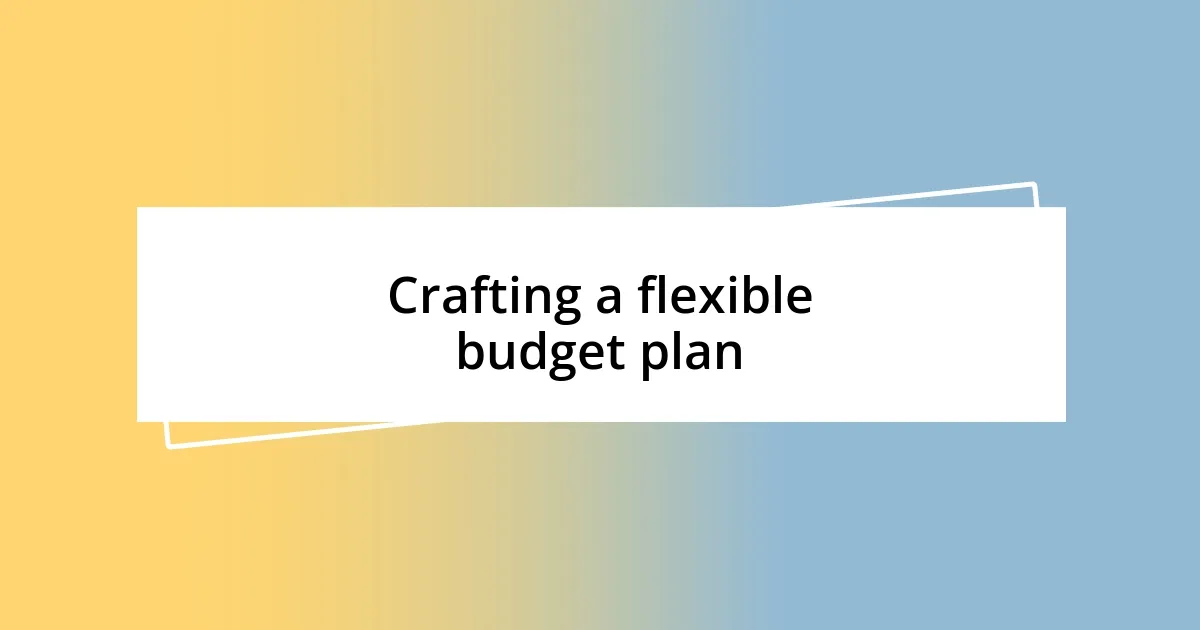Key takeaways:
- Understand the basics of budgeting by distinguishing between needs and wants, and starting with a clear inventory of income and expenses.
- Set realistic financial goals by breaking larger dreams into smaller, manageable steps and aligning them with current financial situations.
- Adopt a flexible budgeting approach, using tools like the 50/30/20 rule and regular reviews to adapt to changing priorities and unexpected expenses.
- Celebrate milestones throughout the budgeting journey to reinforce commitment and recognize progress, making the process more enjoyable and motivating.

Understanding budget basics
Understanding the basics of budgeting is like setting up a roadmap for your financial journey. I remember when I first realized the importance of tracking my expenses; it felt daunting at first. Can you relate to that feeling of overwhelm when faced with all those numbers? What I learned is that starting with an inventory of your income and outgoings transforms that chaos into clarity.
In my experience, distinguishing between needs and wants is crucial. Early on, I caught myself craving that latest gadget, but I had to step back and assess whether it was a necessity or just a fleeting desire. This process taught me that mindful spending doesn’t just save money; it brings a sense of control and empowerment that is genuinely liberating. Have you ever stopped to think about how your spending habits impact your financial health?
Another fundamental aspect of budgeting is setting realistic goals. When I began budgeting, I aimed for a vacation that felt like a dream—impossibly far away. Breaking that goal down into smaller, achievable steps made it tangible. It felt like climbing a mountain; each little milestone was a victory, giving me motivation to push on. How about you? What dreams do you have, and how can budgeting help you bring them into reality?

Setting realistic financial goals
Setting realistic financial goals is pivotal in creating a successful budgeting strategy. I recall the time I wanted to purchase my first home. Initially, I set my target too high. Instead of feeling inspired, I felt defeated. It was only when I started with smaller, incremental savings goals that the process became manageable. This approach transformed my anxiety into a sense of accomplishment when I hit each target. Have you ever felt a similar shift from being overwhelmed to empowered through achievable goals?
As I refined my goal-setting process, I learned the importance of aligning my financial aspirations with my current situation. For example, I decided to prioritize my emergency fund over luxury trips. Although it felt like a sacrifice, I discovered peace of mind knowing I was prepared for unexpected expenses. Ultimately, balancing my immediate needs with future dreams made me feel more grounded. How do you prioritize your financial goals to create a better balance in your life?
Finally, tracking progress on your goals can greatly enhance your motivation. I started using a simple spreadsheet to visualize my savings. Each month, I could see my progress, and it became a rewarding experience. It reminded me to celebrate these small wins along the way. What tools do you use to track your financial journey? Finding the right method for you can be a game-changer.
| Financial Goal Type | Example |
|---|---|
| Short-term Goals | Building an emergency fund |
| Medium-term Goals | Saving for a vacation |
| Long-term Goals | Buying a house |

Merging dreams with budgeting
Finding the sweet spot between dreams and budgeting is truly an art form. When I decided I wanted to travel the world, it felt ambitious, almost fantastical. It wasn’t until I meticulously outlined a budget for each trip, down to daily expenses, that the dream morphed into something achievable. I learned that budgeting could actually be a pathway to my aspirations rather than a barrier. Creating a fund specifically for travel opened doors I never imagined. Sometimes, it’s about reshaping our perspective on what budgeting means in relation to our goals.
To successfully merge dreams with budgeting, I found that prioritizing and aligning my dreams with realistic financial plans was essential. Here are a few strategies that worked wonders for me:
- Create Dream Categories: Divide your dreams into short, medium, and long-term categories. This helps you see where your money needs to go at different stages.
- Set Specific Amounts: Allocate specific amounts towards each category monthly. Watching those amounts grow towards something I wanted felt immensely gratifying.
- Visualize Progress: Use vision boards or charts to track your journey toward your dreams. This adds a creative element that fuels your motivation and keeps your goals at the forefront of your mind.
- Reassess and Adjust: Life happens, so regularly reassessing your budget and dreams helps maintain balance. I’ve experienced the value in tweaking my goals when my financial situation changed—it’s all part of the journey.
Embracing this merging of dreams and budgeting has transformed my approach to both finances and life, making every cent spent feel like an investment in my future.

Prioritizing expenses for dreams
Prioritizing expenses for our dreams can sometimes feel overwhelming, but I’ve found that taking a strategic approach makes all the difference. When I aimed to start my own business, I had to evaluate my spending carefully. Do I splurge on a fancy dinner, or do I invest that money into marketing? Diving deep into these choices helped me funnel my resources into what truly mattered. What if you prioritized your biggest dream—would your spending habits shift?
One technique that really helped me was adopting a “dream first” mindset. I would ask myself explicitly every month: “Which financial decisions today will support my goals tomorrow?” For instance, I switched from daily coffee shop visits to brewing my favorite blend at home. That small change not only saved me money but also contributed to my startup fund. Have you ever realized that minor adjustments to your daily spending could have a significant impact on your long-term aspirations?
As I progressed, I started using budgeting apps that allowed me to categorize my expenses according to my dreams. This enabled me to see, at a glance, how my daily choices aligned with my ultimate goals. The emotional relief of knowing I was actively investing in my future dreams was invigorating. It’s like a light bulb moment when you see your efforts coming to fruition—what goals have you seen progress towards through conscious spending?

Crafting a flexible budget plan
Crafting a flexible budget plan has been a revelation for me. I remember the early days of budgeting, where every expense felt like a restriction on my dreams. But once I learned to create a budget that could adapt to my life’s unpredictability, it truly changed everything. By incorporating a buffer for unexpected costs, I found a sense of freedom in financial planning. How freeing would it feel to adjust your budget without feeling guilty or stressed?
One crucial strategy I embraced was the 50/30/20 rule. This approach allocates 50% of your income to needs, 30% to desires, and 20% to savings or debt repayment. I still recall the day I realized that reallocating those percentages could give me more room to breathe, especially when my travel plans had to shift due to unforeseen circumstances. This simple framework provided clarity and flexibility, ensuring that I could still indulge in my passions without derailing my financial goals.
Regular check-ins with my budget have also made a world of difference. I set aside time each month to review and adjust my allocations based on what worked and what didn’t. During one of these reviews, I discovered I was spending more on streaming services than I realized. By cutting back, I was able to invest in a workshop that fed my entrepreneurial spirit. Reflecting on my desires and making necessary alterations not only keeps me on track but also fosters a proactive mindset—what adjustments have you considered lately that could help you in achieving your dreams?

Tracking progress and making adjustments
Tracking progress is essential in the journey of balancing budgeting and dreams. I’ve found that keeping a simple spreadsheet to log my expenses not only clarifies where my money goes but also serves as a motivational tool. When I see that I’ve saved enough for a dream vacation just by cutting back on impulse buys, it reinforces my commitment. Have you ever felt that sense of accomplishment when you reach a milestone, however small?
Adjustments are part of the process, and I’ve had my share of realizations. There was a month when I noticed my dining out expenses skyrocketed due to my habit of saying “yes” to every social invitation. After that, I decided to approach gatherings differently. Instead of always choosing a restaurant, I suggested dinner parties at home. Not only did this save money, but it also allowed me to connect with friends on a more personal level. How often do we overlook the power of creativity in our spending decisions?
Being flexible isn’t just about the numbers; it’s about attitude. During one of my budget reviews, I discovered my savings weren’t growing as intended because I was too rigid about my allocations. So, I allowed myself to reallocate funds according to new priorities, which felt refreshing. That experience taught me that sometimes our dreams change, and so should our approach to budgeting. What shifts have brought you closer to your aspirations, or what could you adjust today?

Celebrating milestones and successes
Celebrating milestones is a powerful way to reinforce our financial successes and dreams. I vividly remember the thrill of hitting my first savings goal. It wasn’t just about the money; it was a clear indicator that my dedication to budgeting was paying off. I decided to treat myself to a small gift—a book on a topic I was passionate about. That moment reminded me that every step taken deserves recognition, both big and small.
As I worked towards larger goals, like purchasing my first home, the celebrations became even more meaningful. I set mini-celebrations along the way—whether it was a gathering with friends or a simple toast at dinner. When I finally secured my mortgage, I felt a surge of pride and appreciation for the journey. I often ask myself, how can we truly acknowledge our progress in a way that fuels our ambition further?
Reflecting on my budgeting victories also provides a mental boost. I recall after completing a year of diligent saving, I threw a small brunch for close friends. Sharing my journey and hearing their encouragement reinforced my commitment. Have you ever noticed how sharing successes not only motivates you but also inspires those around you? Celebrating along the way makes the entire process enjoyable and rewarding, transforming goals into a shared experience.














